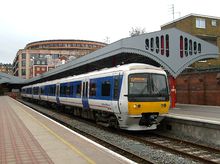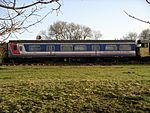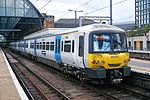Networker (train)
This article needs additional citations for verification. (November 2015) |
| Networker | |
|---|---|
 A Class 165 at Reading in Great Western Railway livery | |
| In service | 1989–present |
| Manufacturer |
|
| Number built | 344 trainsets |
| Number scrapped | 19 sets |
| Operator(s) |
|
| Specifications | |
| Maximum speed | 75–100 mph (121–161 km/h) |
| Track gauge | 1,435 mm (4 ft 8+1⁄2 in) standard gauge |
The Networker is a family of passenger trains which operate on the UK railway system. They were built in the late 1980s and early 1990s by British Rail Engineering Limited (which became part of ABB in the 1990s) and Metro Cammell. The trains were built for the Network SouthEast sector of British Rail, which is where their name comes from. They are all multiple-unit trains.
The Networker design was to become effectively the third generation of British Rail multiple units, and was originally intended to become one of the largest families of trains, bigger even than the largely Mark 3-based Second Generation. The design was supposed to cover all requirements for future NSE multiple units; however, the poor state of the economy in the early 1990s prevented this from happening.
Subsequently, Bombardier Transportation used the Networker as the basis for its successful post-privatisation Turbostar and Electrostar units, having obtained the design through its acquisition of ADtranz, which had absorbed ABB.
DMUs[]
This section does not cite any sources. (June 2021) |
Class 165[]

The Class 165 is a 2- and 3-car diesel multiple unit (DMU), built for outer suburban workings. Thirty-nine units were built for the Chiltern subdivision of Network SouthEast in 1990 and 1991 (Class 165/0), and thirty-seven for the Thames subdivision in 1992 (Class 165/1). Since privatisation, the 165/0 units have been operated by Chiltern Railways, while the 165/1 units have been operated by Thames Trains, First Great Western Link, First Great Western and Great Western Railway in turn. The 165/0s are among the few units in Britain to have ATP installed.
Class 166[]

The Class 166 is a faster, air-conditioned variant of the Class 165, built for main line workings. Twenty-one 3-car units were built for the Thames and North Downs subdivisions of Network SouthEast in 1992 and 1993. Since privatisation, these units have been operated by Thames Trains, First Great Western Link, First Great Western and Great Western Railway in turn.
EMUs[]
Classes 316 and 457[]
These designations applied to a single four car electric multiple unit (EMU), converted from former Class 210 carriages, that was used as a research prototype. The unit was numbered as a Class 457 unit for trials with power from 750 V direct current (DC) third rail on Southern Region lines, then as a Class 316 unit for trials with power from 25 kV alternating current (AC) overhead line equipment on lines north of the River Thames, for which one of its intermediate carriages was replaced with a Class 313 pantograph trailer.
Class 365[]

The Class 365 is a dual-voltage EMU. Forty-one 4-car units were built from 1994 to 1995,[1] the first sixteen fitted with pick-up shoes for power from 750 V DC third rail on services between London and Kent,[2] and the other twenty-five fitted with pantographs for power from 25 kV AC overhead line equipment on services on the East Coast Main Line from London King's Cross to Peterborough and King's Lynn.
Upon privatisation, the DC units passed to Connex South Eastern, and the AC units to West Anglia Great Northern.
The DC units passed from Connex to South Eastern Trains in late 2003; they were then transferred to WAGN in 2004 and converted for AC power, their shoe gear being removed and pantographs fitted. All units (with the exception of one lost in the Potters Bar rail accident of 2002) passed to First Capital Connect in 2006, and then to Great Northern in 2014.
Between mid-2018 and early 2019, ten units were leased to ScotRail in response to a rolling stock shortage, operating on Glasgow to Edinburgh and Stirling services.[3]
Great Northern withdrew its Class 365 fleet on 15 May 2021.[4][5]
Class 465[]

The Class 465 is a 4-car Electric Multiple Unit (EMU), powered from 750 V DC third rail. They were built by British Rail Engineering Limited (465/0), ABB (465/1), and Metro Cammell (465/2) in slightly different versions. Later some of the Metro Cammell units received an internal overhaul and a first-class section was added; formerly numbered 465201-465234, these units are now numbered 465901-465934 and are known as Weald units. Used by Network SouthEast, upon privatisation they passed to Connex South Eastern, then to South Eastern Trains then to Southeastern and are currently operated by SE Trains.
Class 466[]

The Class 466 is a 2-car Electric Multiple Unit (EMU). It is powered from 750 V DC third rail and used extensively in multiple with 4-car 465s to provide 6-car and 10-car formations. 43 units were built between 1993 and 1994 by Metro Cammell (who built the 465/2s) using GEC traction. The 466s are numbered 466001-466043. The arrival of new Electrostar (class 376/0) stock has seen some units move to rural lines to operate 2-car shuttles, displacing half of the Class 508s.
Proposals[]
Class 341 and 342[]
Class 341 and 342 were EMU types that were proposed but never built. Class 341 was intended to be the rolling stock for Crossrail prior to its cancellation in the early 1990s; the specifications for this class were later used in drawing up the rolling stock specifications for the current incarnation of Crossrail. Class 342 was intended for use on domestic services using the Channel Tunnel Rail Link when it opened in 1994. In the end these services were abandoned, and no trains were constructed.[6]
Class 371, 381 and 471[]
Class 371, 381 and 471 were three further EMU types intended as part of the Networker series. Classes 371 and 381 were proposed as the "Universal Networker", a dual voltage train type for a multitude of services including Kent Coast, Great Northern, Thameslink and LTS routes. Class 471 was the proposed "main line Networker" intended for long-distance services from London to Kent and Sussex.
Variants[]
This section does not cite any sources. (June 2021) |
| Class | Image | Operator | Introduced | Number | Carriages | End gangways | Car length | Notes |
|---|---|---|---|---|---|---|---|---|
| Diesel multiple units | ||||||||
| 165 |  |
Chiltern Railways | 1990–1992 | 39 | 2 or 3 | No | 22 m (74 ft 6 in) | |
| ||||||||

|
Great Western Railway | 1992 | 36 | 2 or 3 | No | 22 m (74 ft 6 in) | ||
| ||||||||
| 166 |  |
1992–1993 | 21 | 3 | No | 22 m (74 ft 6 in) | ||
| Dual-voltage | ||||||||
| 316 and 457 |  |
British Rail | 1989–1990 | 1 | 4 | Yes | This was the prototype of the Networkers, initially as the 316 and then converted to the 457. | |
| 371, 381 and 471 | Never built | Yes, 471 only | Proposed electric multiple unit classes from the Networker family of trains intended to operate services in the southeast of England. | |||||
| Pantograph | ||||||||
| 341 and 342 | Never built | No | This was designed for BR's Crossrail but then the design, like the original Crossrail plan, was dropped. | |||||
| 365 |  |
Stored | 1994–1995 | 41 | 4 | 20 m (65 ft 9 in) | 40 units stored along with the remaining vehicles of 365 526 which have been stored out of use after Potters Bar rail accidents. | |
| Contact shoe | ||||||||
| 465 |  |
Southeastern | 1991–1994 | 147 | 4 | No | 20 m (65 ft 9 in) | |
| 466 |  |
1993–1994 | 43 | 2 | No | 20 m (65 ft 9 in) | ||
References[]
- ^ "Class 365 Electric Multiple Unit" (PDF). Eversholt Rail Group. Archived from the original (PDF) on 2 September 2018. Retrieved 27 June 2021.
- ^ Connex South Eastern: Train Operating Manual Classes 365, 465, 466. p.A.9 (Class 365 Unit Formation) January 1998. Retrieved 14 February 2011.
- ^ Dalton, Alastair (23 April 2018). "New ScotRail trains to ease crush on Edinburgh–Glasgow line". The Scotsman. Archived from the original on 25 April 2018. Retrieved 4 May 2018.
- ^ Great Northern [@GNRailUK] (15 May 2021). "Today We Bid Farewell to Our Class 365s" (Tweet). Retrieved 30 August 2021 – via Twitter.
- ^ "Farewell Service Sees Last Last [sic] Great Northern Class 365 out of London King's Cross". RailAdvent. 22 May 2021. Retrieved 3 September 2021.
- ^ "Part 4: Electric Multiple Units" (PDF). TheRailwayCentre.com. 2 May 2006. Archived from the original (PDF) on 7 February 2012. Retrieved 5 November 2015.
- British Rail brands
- Multiple units of Great Britain
- Train-related introductions in 1990